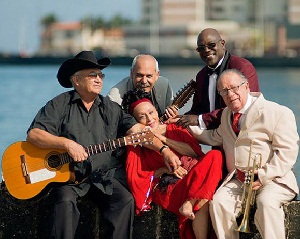 The Buena Vista Social Club was a very popular Havana dance hall in the 1940s and 50s, but that name is now known throughout the world as a Cuban musical phenomenon.
The Buena Vista Social Club was a very popular Havana dance hall in the 1940s and 50s, but that name is now known throughout the world as a Cuban musical phenomenon.
It was a project born 20 years ago, under the direction of Juan de Marcos González, former director of the Sierra Maestra group, with renowned U.S. guitarist Ry Cooder as producer.
The original album was recorded, as Cuban journalist Juan Carlos Roque recalled, by World Circuit Records, over “seven intense days in Havana in 1996.”
From its launch, the Buena Vista Social Club became an extraordinary success, with concerts held in the main capitals of the world, millions in album sales, and even famous German film director, Win Wenders, made a documentary on the group, which includes the second concert at New York’s Carnegie Hall.
Last year, Roque published in Argentina the book Cómo Cuba puso a bailar al mundo (How Cuba Made the World Dance), with Libros en Red publishing house. The text has now been republished by Cuba’s Ediciones UNIÓN, and will be presented in Havana’s San Carlos de la Cabaña Fortress, the main venue of this year’s International Book Fair.
The book features a series of interviews Roque conducted in 1999 and 2000, with all the members of the initial project, as part of the series The Road to Success, in which he recreates the life and work of the founder members.
In a brief conversation at the headquarters of the Union of Writers and Artists of Cuba (UNEAC), the author explained that he decided to compile the interviews after the announcement of the group’s Adiós Tour of farewell concerts, which he later enriched and contextualized as result of further encounters with some of the musicians.
“The book begins when they appear in the White House in 2015, and play for President Obama, given what that represented for cultural exchange between Cuba and the United States. It then recreates those original interviews, almost one chapter per musician. I go on like this, revealing the development of the group.”
Among the 14 interviews included in the book, some of the most interesting are those with Buena Vista greats Juan de Marcos; Francisco Repilado, known as ”Compay Segundo”; Omara Portuondo; Ibrahim Ferrer; Rubén González; Eliades Ochoa; and Alberto Virgilio Valdés.
Readers can appreciate the relaxed tone of the dialogues on the lives of these musicians, who were mostly retired, and their surprise on making a comeback to the stage.
In addition to the testimonies of the protagonists, Roque includes notes, including one dedicated to the Adiós Tour, with reference to the album Lost and Found, including original songs and photos of his encounters with the interviewees.
In reference to the title, the author noted:” Well, actually I think it should be called “How Cuba made the world dance once again,” but that’s another book. At that stage, the phenomenon of Buena Vista revitalized Cuban music.”
Last year, Roque published in Argentina the book Cómo Cuba puso a bailar al mundo (How Cuba Made the World Dance), with Libros en Red publishing house. The text has now been republished by Cuba’s Ediciones UNIÓN, and will be presented in Havana’s San Carlos de la Cabaña Fortress, the main venue of this year’s International Book Fair.
The book features a series of interviews Roque conducted in 1999 and 2000, with all the members of the initial project, as part of the series The Road to Success, in which he recreates the life and work of the founder members.
In a brief conversation at the headquarters of the Union of Writers and Artists of Cuba (UNEAC), the author explained that he decided to compile the interviews after the announcement of the group’s Adiós Tour of farewell concerts, which he later enriched and contextualized as result of further encounters with some of the musicians.
“The book begins when they appear in the White House in 2015, and play for President Obama, given what that represented for cultural exchange between Cuba and the United States. It then recreates those original interviews, almost one chapter per musician. I go on like this, revealing the development of the group.”
Among the 14 interviews included in the book, some of the most interesting are those with Buena Vista greats Juan de Marcos; Francisco Repilado, known as ”Compay Segundo”; Omara Portuondo; Ibrahim Ferrer; Rubén González; Eliades Ochoa; and Alberto Virgilio Valdés.
Readers can appreciate the relaxed tone of the dialogues on the lives of these musicians, who were mostly retired, and their surprise on making a comeback to the stage.
In addition to the testimonies of the protagonists, Roque includes notes, including one dedicated to the Adiós Tour, with reference to the album Lost and Found, including original songs and photos of his encounters with the interviewees.
In reference to the title, the author noted:” Well, actually I think it should be called “How Cuba made the world dance once again,” but that’s another book. At that stage, the phenomenon of Buena Vista revitalized Cuban music.”
(Granma)